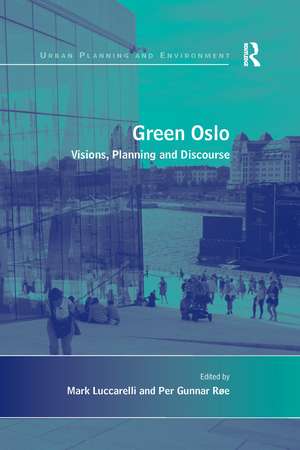Green Oslo: Visions, Planning and Discourse
Autor Per Gunnar Røe Editat de Mark Luccarellien Limba Engleză Paperback – 9 sep 2016
| Toate formatele și edițiile | Preț | Express |
|---|---|---|
| Paperback (1) | 469.34 lei 6-8 săpt. | |
| Taylor & Francis – 9 sep 2016 | 469.34 lei 6-8 săpt. | |
| Hardback (1) | 1060.25 lei 6-8 săpt. | |
| Taylor & Francis – 14 ian 2013 | 1060.25 lei 6-8 săpt. |
Preț: 469.34 lei
Nou
Puncte Express: 704
Preț estimativ în valută:
89.82€ • 97.53$ • 75.45£
89.82€ • 97.53$ • 75.45£
Carte tipărită la comandă
Livrare economică 23 aprilie-07 mai
Preluare comenzi: 021 569.72.76
Specificații
ISBN-13: 9781138246775
ISBN-10: 1138246778
Pagini: 308
Dimensiuni: 156 x 234 x 22 mm
Greutate: 0.45 kg
Ediția:1
Editura: Taylor & Francis
Colecția Routledge
Locul publicării:Oxford, United Kingdom
ISBN-10: 1138246778
Pagini: 308
Dimensiuni: 156 x 234 x 22 mm
Greutate: 0.45 kg
Ediția:1
Editura: Taylor & Francis
Colecția Routledge
Locul publicării:Oxford, United Kingdom
Notă biografică
Mark Luccarelli is an Associate Professor of North American Studies at the Department of Literature, Area Studies and European Languages, University of Oslo, Norway and Per Gunnar Roe, Associate Professor of Human Geography, Department of Sociology and Human Geography, University of Oslo, Norway.
Recenzii
’Green infrastructure is an important aspect of urban sustainability for human wellbeing and for enhancing biological diversity, and this timely volume gives a thorough and much needed critical analysis of green urbanism in theory and practice. Oslo is well suited as a showcase for elucidating the challenges of green planning in urban areas.’ Marie Stenseke, University of Gothenburg, Sweden ’Green Oslo: Visions, Planning and Discourse critically elucidates the sustainability challenges facing all cities today. This comprehensive case study of Oslo draws on many perspectives and asks crucial questions, such as, can cities be green? It will be of great interest to planners, sustainability scientists, environmental urbanists and activists alike. An exemplar for research into urban sustainability issues, I hope the book’s goal of a series of similarly thorough case studies of other cities around the world is pursued.’ Eric Clark, Lund University, Sweden 'This book offers in-depth discussions on selected aspects of a sustainable city. Using the Norwegian capital of Oslo as an example, it asks how the city may be understood and interpreted as ’green’ from different angles and within a variety of theoretical perspectives. It focuses on the urban green spaces and the complex cultural and social aspects of ’green Oslo’. It deals with green city planning and its implementation ... it is a complete, beautiful, and most handy book ... compulsive reading for all those who are closely or in a remote way dealing with the sustainability challenges facing all cities today.' International Journal of Environment and Pollution 'This book adds a unique perspective and set of tactics to the task of creating a truly green urbanism.' Journal of Planning Education and Research
Cuprins
Introduction: Nature, Urbanism and Liveability; I: Visions, metaphors and patterns; 1: Biophilic Oslo; 2: Oslo: A City Framed by Forest; 3: Recollections of an Urban Green: The Frogner Park; 4: Oslo's Ullevål Garden City: An Experiment in Urbanism and Landscape Design; II: Policies, discourses and dilemmas; 5: Can Cities be Green?; 6: Shifts in Planning Ideology and Consequences for Residential Green Areas: A Historical Survey of Planning Concepts and Attitudes Towards Green Areas in Housing Estates in Oslo; 7: Green Suburbanisms: Differentiating the Greenness of Suburbs; 8: Driving Spaces and the Dilemma of the Green City; 9: Design with Nature: The Gardener's View; III: Plans, politics and outcomes; 10: How Green is Oslo? Urban Development, Green Policies and the Making of a Green Capital City; 11: Planning for a Green Oslo; 12: Planning a Compact Oslo
Descriere
As urban regions face the demand to decrease fossil fuel dependency, many cities in the developing world are undertaking initiatives designed to create a greener city by aiming for a more sustainable form of urban development and, to do so, they need to evaluate existing modes of transportation and patterns of land use. This book provides an opportunity for a critical assessment of the limitations and opportunities inherent in 'green Oslo' and suggests the need for much broader integrative approaches. It concludes by highlighting lessons which other cities might learn from Oslo.
